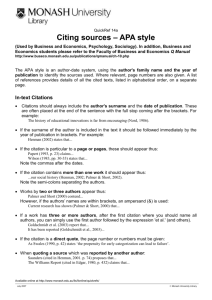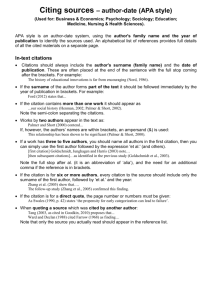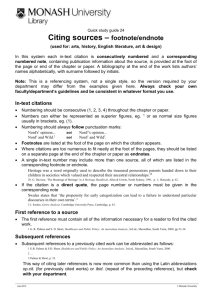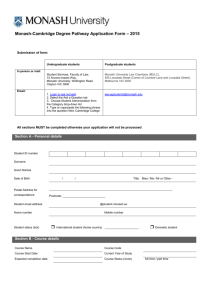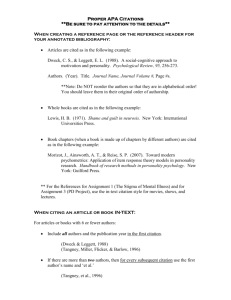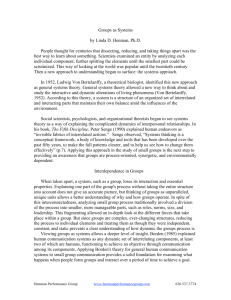Citing sources – author-date \(Faculty of Business and Economics\)
advertisement
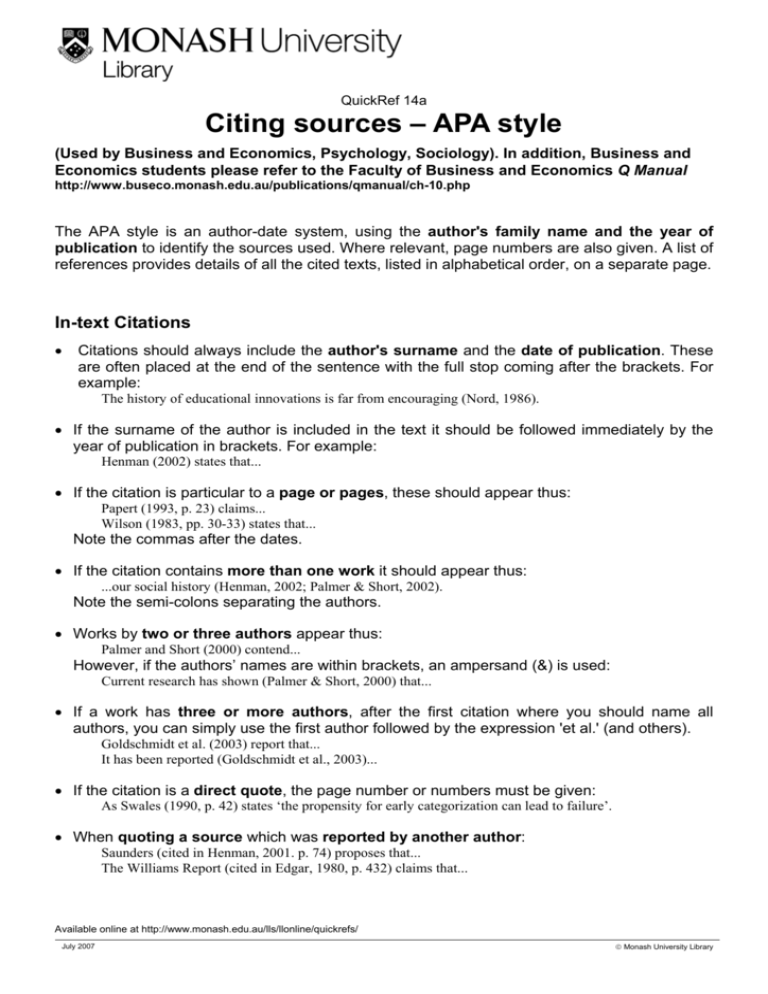
QuickRef 14a Citing sources – APA style (Used by Business and Economics, Psychology, Sociology). In addition, Business and Economics students please refer to the Faculty of Business and Economics Q Manual http://www.buseco.monash.edu.au/publications/qmanual/ch-10.php The APA style is an author-date system, using the author's family name and the year of publication to identify the sources used. Where relevant, page numbers are also given. A list of references provides details of all the cited texts, listed in alphabetical order, on a separate page. In-text Citations • Citations should always include the author's surname and the date of publication. These are often placed at the end of the sentence with the full stop coming after the brackets. For example: The history of educational innovations is far from encouraging (Nord, 1986). • If the surname of the author is included in the text it should be followed immediately by the year of publication in brackets. For example: Henman (2002) states that... • If the citation is particular to a page or pages, these should appear thus: Papert (1993, p. 23) claims... Wilson (1983, pp. 30-33) states that... Note the commas after the dates. • If the citation contains more than one work it should appear thus: ...our social history (Henman, 2002; Palmer & Short, 2002). Note the semi-colons separating the authors. • Works by two or three authors appear thus: Palmer and Short (2000) contend... However, if the authors’ names are within brackets, an ampersand (&) is used: Current research has shown (Palmer & Short, 2000) that... • If a work has three or more authors, after the first citation where you should name all authors, you can simply use the first author followed by the expression 'et al.' (and others). Goldschmidt et al. (2003) report that... It has been reported (Goldschmidt et al., 2003)... • If the citation is a direct quote, the page number or numbers must be given: As Swales (1990, p. 42) states ‘the propensity for early categorization can lead to failure’. • When quoting a source which was reported by another author: Saunders (cited in Henman, 2001. p. 74) proposes that... The Williams Report (cited in Edgar, 1980, p. 432) claims that... Available online at http://www.monash.edu.au/lls/llonline/quickrefs/ July 2007 Monash University Library List of References Notice details such as punctuation, abbreviations, italics and use of capitals in the following basic examples. For other types of materials, refer to the Q Manual. • Basic format for a book Family name, initial(s). (Year). Title of book, minimal capitalisation. Place of publication: publisher. McIlroy, D. (2003). Studying at university (3rd ed.). Oxford: Oxford University Press. • Basic format for a journal article Family name, initials(s). (year). Name of article, minimal capitalisation. Title of Journal, Maximum Capitalisation, volume number(issue number), page numbers of the article. Borrel, J. & James. N. (2004). Red-hot China lures two new funds. Private Equity Week, 11(44), 1-9. • A journal from a Monash database A journal in PDF format is referenced like a print journal. If the journal is only available in HTML format, include the name of the database, but not the date you accessed the journal. Ram, R. (1999). Managing autonomy: Employment relations in small service firms. International Small Business Journal, 17(2), 13-30. Retrieved from Business Source Premier database. • Sources from the web If the material will not change (e.g. a newspaper article) give the URL but not the date you accessed the material. If the material may be updated or changed, give the URL and the date you accessed the source, in this order. BHPBiliton. (2006). Resourcing the future. Retrieved July 10, 2008, from http://www.bhpbiliton.com/bb/home.jsp • Example List of References (Note the hanging indent and spacing between entries) Ansari, A. (1999). Langevin modes of analysis of myoglobin. Journal of Chemical Physics, 110 (3). Retrieved April 18, 2004, from http://ojps.aip.org/journals/doc/vol_110/iss.html Burka, L.P. (2003 – last updated November 22). A hypertext history of multi-user dungeons. Retrieved January 22, 2004, from http://www.utopia.com/talent/lpb/muddex/muddex.htm Department of Industry, Science and Technology. (2004). Australian business innovation: A strategic analysis. Canberra: Australian Government Printing Service Dowling, R.K. (1999). Marketing the key to successful wine tourism. Australian-and-New-Zealand-Wine-IndustryJournal, 12 (5) 63-65. Networked CD-ROM, Available: Tour CD/CAB Abstracts/CAB International/19991811764. Goldschmidt, S., Junghagen, S. & Harris, U. (2003). Strategic affiliate marketing, Cheltenham, UK: Edward Elgar Publishing. Henman, P. (2002). Myths of welfare reform. Australian Journal of Social Issues, 37(1), 71-84. International Narcotics Control Board. (2002). Retrieved July 2, 2002, from http:www.incb.org Paige, R.M. (Ed.). (1993). Education for the intercultural experience. Maine: Intercultural Press. Palmer, G.R. & Short, S.D. (2000). Healthcare and public policy: An Australian analysis (3rd ed.).South Yarra: Macmillan. Sked, A. (2003a). The political parties. In J. Hollowell (Ed.), Britain since 1945. Oxford: Blackwell, pp. 40-58. Sked, A. (2003b). England and its politics. Oxford: Oxford University Press. July 2007 Monash University Library
